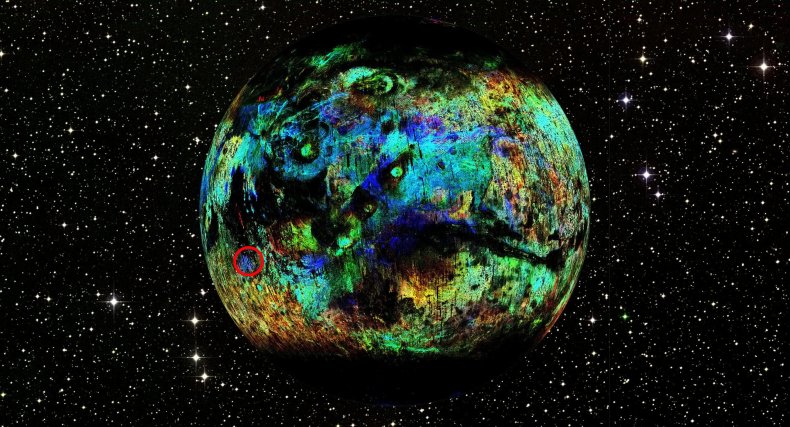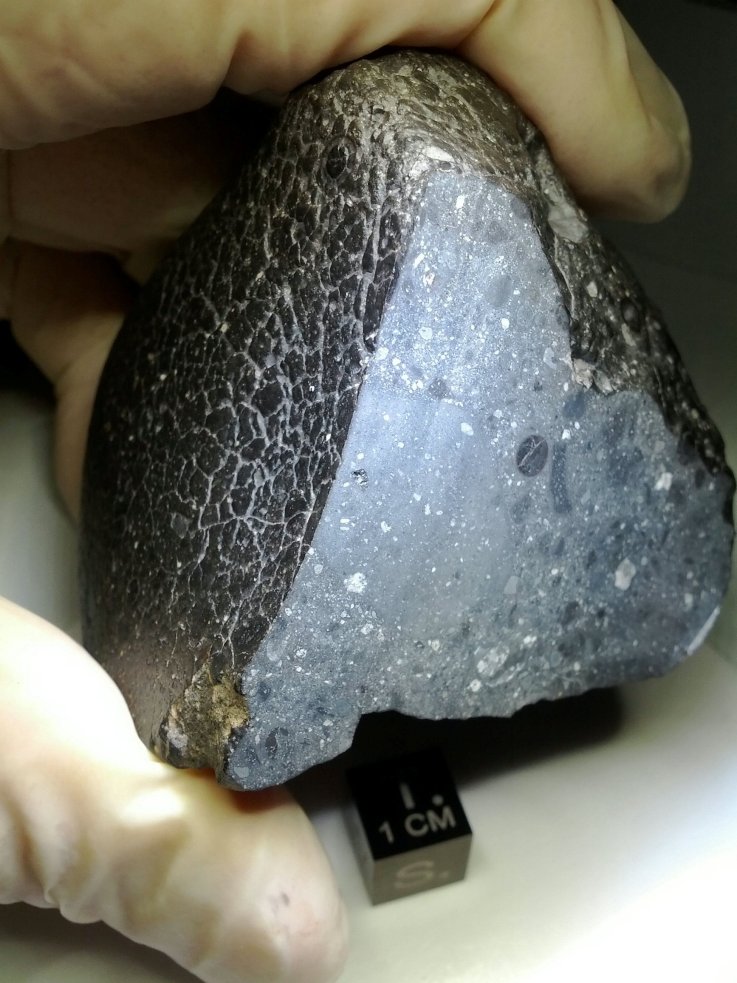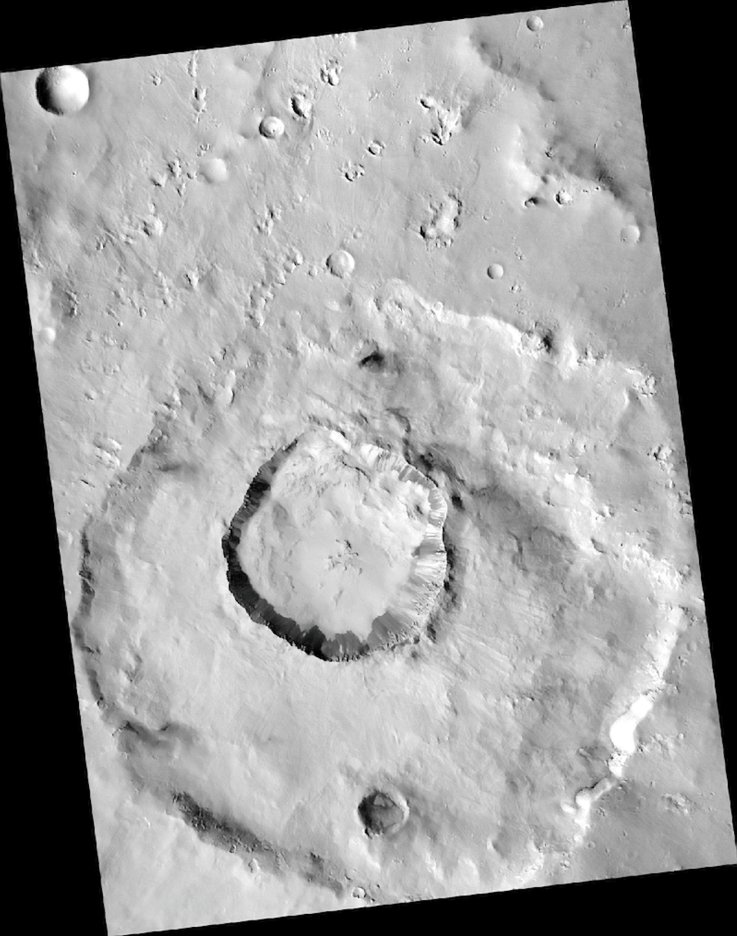BY DARKO MANEVSKI, ZENGER NEWS
ON 7/12/22
The world's oldest Martian meteorite has been traced to the precise crater where it originated.
Named Black Beauty, it formed almost 4.5 billion years ago and adds to evidence the Red Planet was once habitable.
The famous space rock found in the western Sahara of Africa formed part of a primordial crust that hosted oceans of water.
Now, an international team has pinpointed its exact home.

The world's oldest Martian meteorite has been traced to the precise crater where it originated.
Named Black Beauty, it formed almost 4.5 billion years ago and adds to evidence the Red Planet was once habitable.
The famous space rock found in the western Sahara of Africa formed part of a primordial crust that hosted oceans of water.
Now, an international team has pinpointed its exact home.

The world's oldest Martian meteorite has been traced to the precise crater where it originated. Scientists used a supercomputer to track its creation on the red planet in a province known as Terra Cimmeria-Sirenum, seen circled on the graphic.
STEVE CHATTERLEY, SWNS/ZENGER
They used a supercomputer to track its creation on the red planet in a province known as Terra Cimmeria-Sirenum.
The location in the southern hemisphere of the planet has many gullies that could have been carved by flowing rivers. Black Beauty contains more water than other Martian meteorites.
The crater Black Beauty is from has been named Karratha after a city in the Pilbara area of western Australia renowned for its remarkably preserved rock formations.
They used a supercomputer to track its creation on the red planet in a province known as Terra Cimmeria-Sirenum.
The location in the southern hemisphere of the planet has many gullies that could have been carved by flowing rivers. Black Beauty contains more water than other Martian meteorites.
The crater Black Beauty is from has been named Karratha after a city in the Pilbara area of western Australia renowned for its remarkably preserved rock formations.

The meteorite named "Black Beauty" formed almost 4.5 billion years ago and adds to evidence that Mars was once habitable.
STEVE CHATTERLEY, SWNS/ZENGER
"For the first time, we know the geological context of the only brecciated Martian sample available on Earth, 10 years before the NASA's Mars Sample Return mission is set to send back samples collected by the Perseverance rover currently exploring the Jezero crater," said lead author Dr. Anthony Lagain, of Curtin University in Perth, Australia.
The international team want NASA to prioritize the area around Karratha Crater as a future landing site on Mars.
Perseverance landed on Christmas Day and is currently drilling for potential past signs of life.
"Finding the region where the 'Black Beauty' meteorite originates is critical because it contains the oldest Martian fragments ever found, aged at 4.48 billion years old, and it shows similarities between Mars' very old crust, aged about 4.53 billion years old, and today's Earth continents," Lagain said.
"The region we identify as being the source of this unique Martian meteorite sample constitutes a true window into the earliest environment of the planets, including the Earth, which our planet lost because of plate tectonics and erosion."
The study in the journal Nature Communications offers never-before-known details about the Black Beauty, known scientifically as NWA 7034.
READ MOREHow to See Huge Passing Comet at Its Closest Point to Earth
NASA Warns Pressure Test This Weekend Will Sound Like Explosive Boom
Passenger Can't Believe View out the Plane Over Arizona: 'Meteor Crater'
It is the only brecciated Martian sample on Earth - meaning angular fragments of multiple rocks cemented together. All others contain single types.
A machine learning or AI (artificial intelligence) algorithm identified about 90 million impact craters.
Black Beauty's ejection site was found through analyzing thousands of high-resolution images from a range of Mars missions.
"For the first time, we know the geological context of the only brecciated Martian sample available on Earth, 10 years before the NASA's Mars Sample Return mission is set to send back samples collected by the Perseverance rover currently exploring the Jezero crater," said lead author Dr. Anthony Lagain, of Curtin University in Perth, Australia.
The international team want NASA to prioritize the area around Karratha Crater as a future landing site on Mars.
Perseverance landed on Christmas Day and is currently drilling for potential past signs of life.
"Finding the region where the 'Black Beauty' meteorite originates is critical because it contains the oldest Martian fragments ever found, aged at 4.48 billion years old, and it shows similarities between Mars' very old crust, aged about 4.53 billion years old, and today's Earth continents," Lagain said.
"The region we identify as being the source of this unique Martian meteorite sample constitutes a true window into the earliest environment of the planets, including the Earth, which our planet lost because of plate tectonics and erosion."
The study in the journal Nature Communications offers never-before-known details about the Black Beauty, known scientifically as NWA 7034.
READ MOREHow to See Huge Passing Comet at Its Closest Point to Earth
NASA Warns Pressure Test This Weekend Will Sound Like Explosive Boom
Passenger Can't Believe View out the Plane Over Arizona: 'Meteor Crater'
It is the only brecciated Martian sample on Earth - meaning angular fragments of multiple rocks cemented together. All others contain single types.
A machine learning or AI (artificial intelligence) algorithm identified about 90 million impact craters.
Black Beauty's ejection site was found through analyzing thousands of high-resolution images from a range of Mars missions.

Black Beauty's ejection site on the Red Planet was found through analyzing thousands of high-resolution images from a range of Mars missions. The Karratha crater was formed 5 to 10 billion years ago when an asteroid smashed into Mars. It propelled the chunk of ancient Martian crust into space which eventually crashed into the African desert.
STEVE CHATTERLEY, SWNS/ZENGER
Lagain and colleagues found the Karratha crater was formed 5 to 10 billion years ago when an asteroid smashed into Mars. It propelled the chunk of ancient Martian crust into space which eventually crashed into the African desert.
Remains of Black Beauty were discovered in Western Sahara, Africa, in 2011. It was made when the crusts of both Earth and Mars were still young.
Now that we know the source, researchers can compare the formation of both planets. The technology will identify the source of other Martian meteorites - and billions of impact craters on Mercury and the Moon.
It paves the way to locate the ejection site of other Martian meteorites to assemble the most exhaustive view of the Red Planet's geological history.
More than 300 Martian meteorites have been found on Earth to date.
Co-author Professor Gretchen Benedix, also from Curtin, said: "We are also adapting the algorithm that was used to pinpoint Black Beauty's point of ejection from Mars to unlock other secrets from the Moon and Mercury.
"This will help to unravel their geological history and answer burning questions that will help future investigations of the Solar System such as the Artemis program to send humans on the Moon by the end of the decade or the BepiColombo mission, in orbit around Mercury in 2025."
Black Beauty is less than 2 inches long and weighs about 11 ounces. It is owned by a private collector - and valued at up to $118,900.
Produced in association with SWNS.
Lagain and colleagues found the Karratha crater was formed 5 to 10 billion years ago when an asteroid smashed into Mars. It propelled the chunk of ancient Martian crust into space which eventually crashed into the African desert.
Remains of Black Beauty were discovered in Western Sahara, Africa, in 2011. It was made when the crusts of both Earth and Mars were still young.
Now that we know the source, researchers can compare the formation of both planets. The technology will identify the source of other Martian meteorites - and billions of impact craters on Mercury and the Moon.
It paves the way to locate the ejection site of other Martian meteorites to assemble the most exhaustive view of the Red Planet's geological history.
More than 300 Martian meteorites have been found on Earth to date.
Co-author Professor Gretchen Benedix, also from Curtin, said: "We are also adapting the algorithm that was used to pinpoint Black Beauty's point of ejection from Mars to unlock other secrets from the Moon and Mercury.
"This will help to unravel their geological history and answer burning questions that will help future investigations of the Solar System such as the Artemis program to send humans on the Moon by the end of the decade or the BepiColombo mission, in orbit around Mercury in 2025."
Black Beauty is less than 2 inches long and weighs about 11 ounces. It is owned by a private collector - and valued at up to $118,900.
Produced in association with SWNS.
No comments:
Post a Comment